USNI News polled its writers, naval analysts and service members on what they consider the most important military and maritime stories in 2018. This story is part of USNI News year-end series.
F-35C Joint Strike Fighter
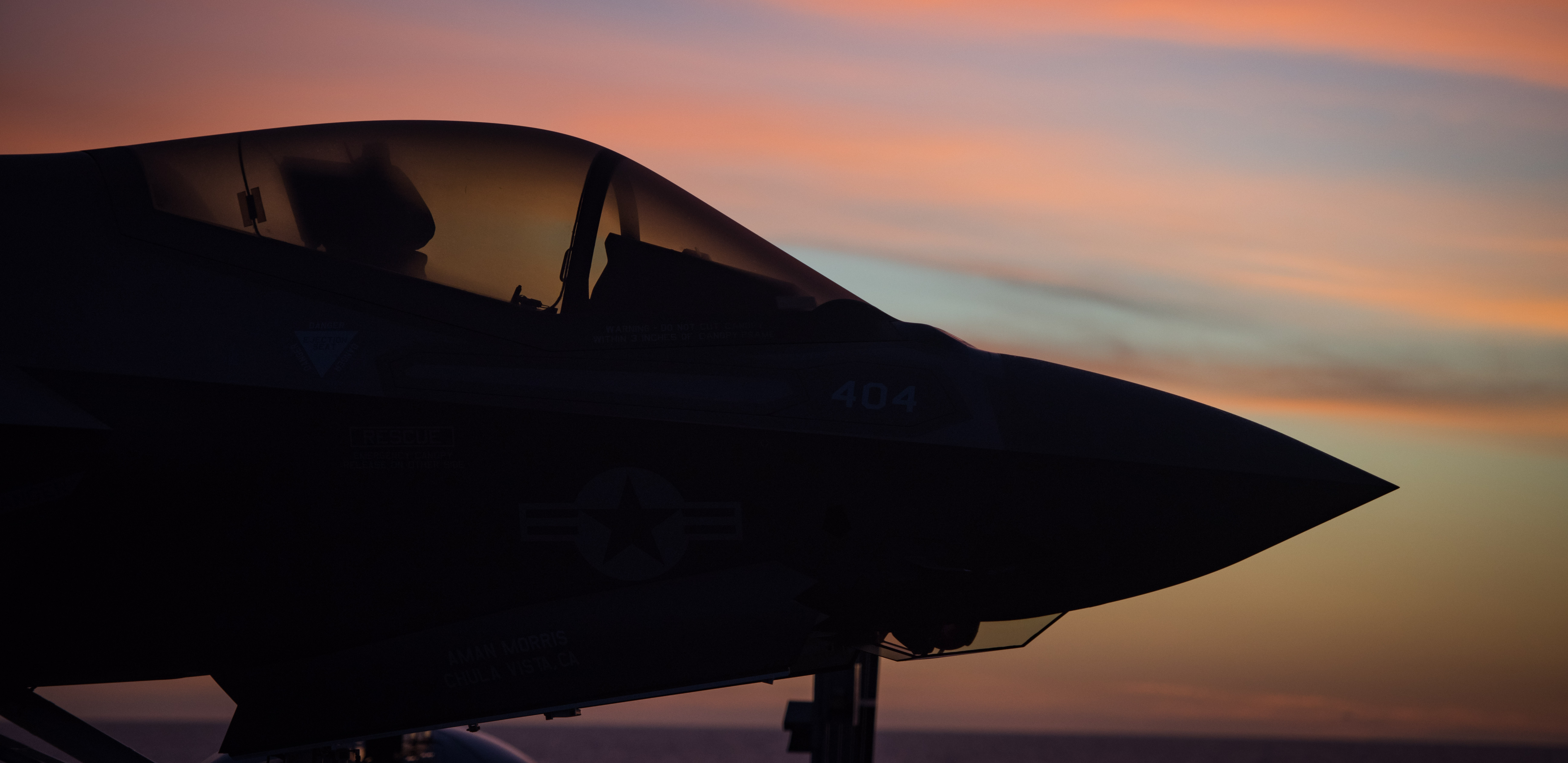
The Navy’s F-35C had an important year, with the fighter seeing its first integrated air wing operations and the first operational F-35C squadron being given a safe-for-flight certification that should pave the way for an initial operational capability (IOC) declaration in the next two months.
In August, Carrier Air Wing 7 swapped out a Super Hornet squadron for a squadron’s worth of F-35Cs and conducted cyclical flight deck operations, launching and recovering F-35Cs alongside F/A-18E-F Super Hornets, E-2D Advanced Hawkeyes, EA-18G Growlers and C-2A Greyhounds for the first time.
The planes came from the “Rough Riders” of Strike Fighter Squadron (VFA) 125 and the “Argonauts” of VFA-147 – an F-35C fleet replacement squadron and operational squadron, respectively, out of Naval Air Station Lemoore, Calif. – and proved they could be not only launched and recovered but also maintained and sustained at sea.
During the same at-sea period aboard USS Abraham Lincoln (CVN-72), film crews from the Top Gun: Maverick sequel were filming background footage on the carrier for the movie, almost certainly assuring the F-35C at least a passing appearance in the movie.
Also during the at-sea period, an F-35C from VFA-125 was damaged during an aerial refueling with an F/A-18F, though both aircraft returned to Lincoln safely and no one was injured.
Though the Navy had previously hoped to reach IOC by the end of 2018, the Navy stood up a Joint Strike Fighter Wing on Oct. 1 to oversee the growing F-35C fleet, and leadership said they were confident in a February 2019 target for IOC.
A major F-35 contract was agreed to between the Pentagon and Lockheed Martin in September that would cover all three variants for the U.S. and international partners in a Lot 11 buy. A second contract action to keep Lots 12 through 14 moving forward during negotiations was issued in November. Also at the program-wide level, “formal Initial Operational Test and Evaluation (IOT&E) to measure the effectiveness, suitability, lethality, survivability and overall mission capability of the F-35 weapons system” began in early December ahead of the Pentagon’s decision to approve Milestone C and move into full-rate production.
Aviation
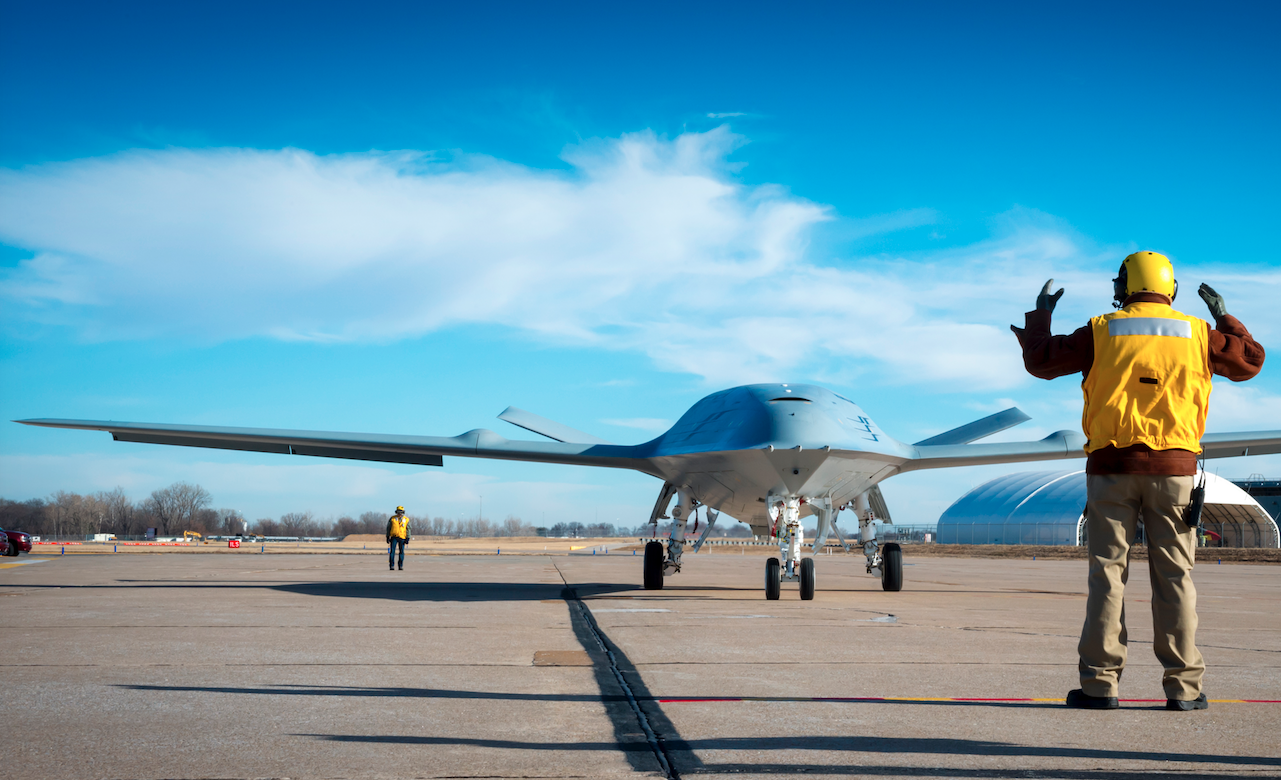
Elsewhere in the Navy aviation portfolio, the Navy selected Boeing to build its MQ-25A Stingray unmanned carrier-based tanker. Boeing beat out Lockheed Martin and General Atomics to win the $805-million contract to build the first four vehicles, which are expected to be flying by 2021 and reach IOC by 2024.
As the Navy looks to replace its 27 legacy C-2A Greyhounds with 38 of the Navy-variant CMV-22B Osprey, the service accelerated the transition schedule in 2018. In January, the service said in an environmental impact statement that the transition would begin in 2020 and should end by 2026, with the full fielding of the new V-22s coming in 2028. In October the Navy elaborated in a congressional hearing that the first planes would deliver in 2020 and deploy in 2021 thanks for a compressed testing schedule.
The Navy bought its CMV-22Bs in a June contract with Bell-Boeing that also covered aircraft for the Marine Corps, Air Force and Japan.
Surface Combatants
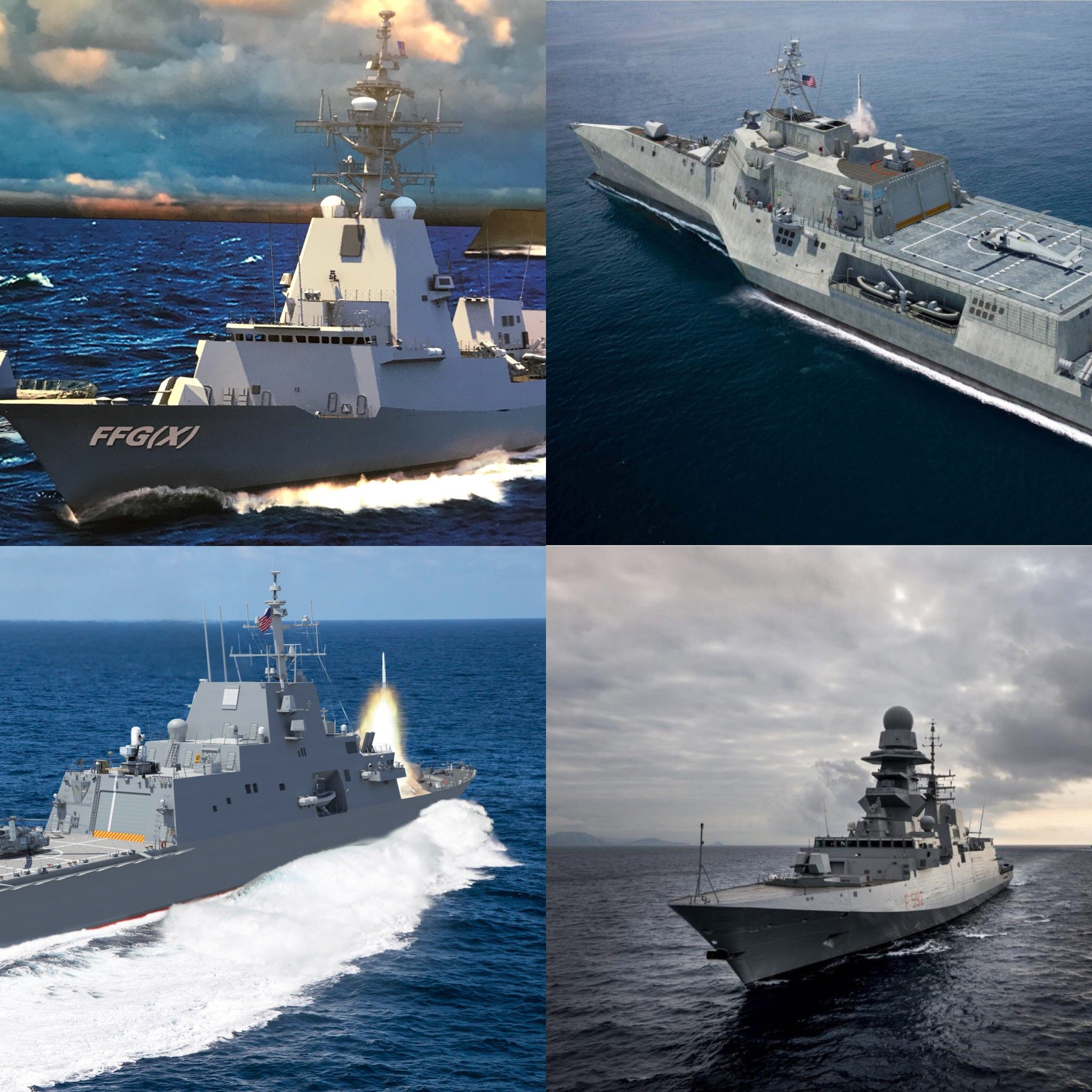
The Navy wrapped up the year with Chief of Naval Operations Adm. John Richardson setting an aggressive timeline for four new surface ship classes, highlighting the upcoming need for new surface combatants but the ongoing uncertainty about how to fill that need.
In the short term, the Navy this year picked five contenders for its guided-missile frigate program that will supplement the Littoral Combat Ship. The February contract award kicked off conceptual design work that will lead to bids being placed in 2019 and a downselect and construction contract award in 2020. LCS builders Austal USA and Lockheed Martin, along with General Dynamics Bath Iron Works, Fincantieri Marine and Huntington Ingalls Industries, were each awarded $15 million contracts for the design work. In July, the Navy released more money to each of these companies to further mature their designs.
Beyond plans for the frigate, though, the future of the surface fleet is still very much in flux. The Navy has a Future Surface Combatant family of systems planned that will include a large combatant to replace cruisers and destroyers, a small combatant to replace the LCS and frigate, and two sizes of unmanned or optionally manned combatants. Though the Navy has said the large combatant would leverage key technology investments from the Zumwalt-class destroyer and would use the DDG-51 Flight III combat system that pairs the Aegis weapon system and AN/SPY-6(V) Air and Missile Defense Radar (AMDR), little else has been announced. More information is expected in January.
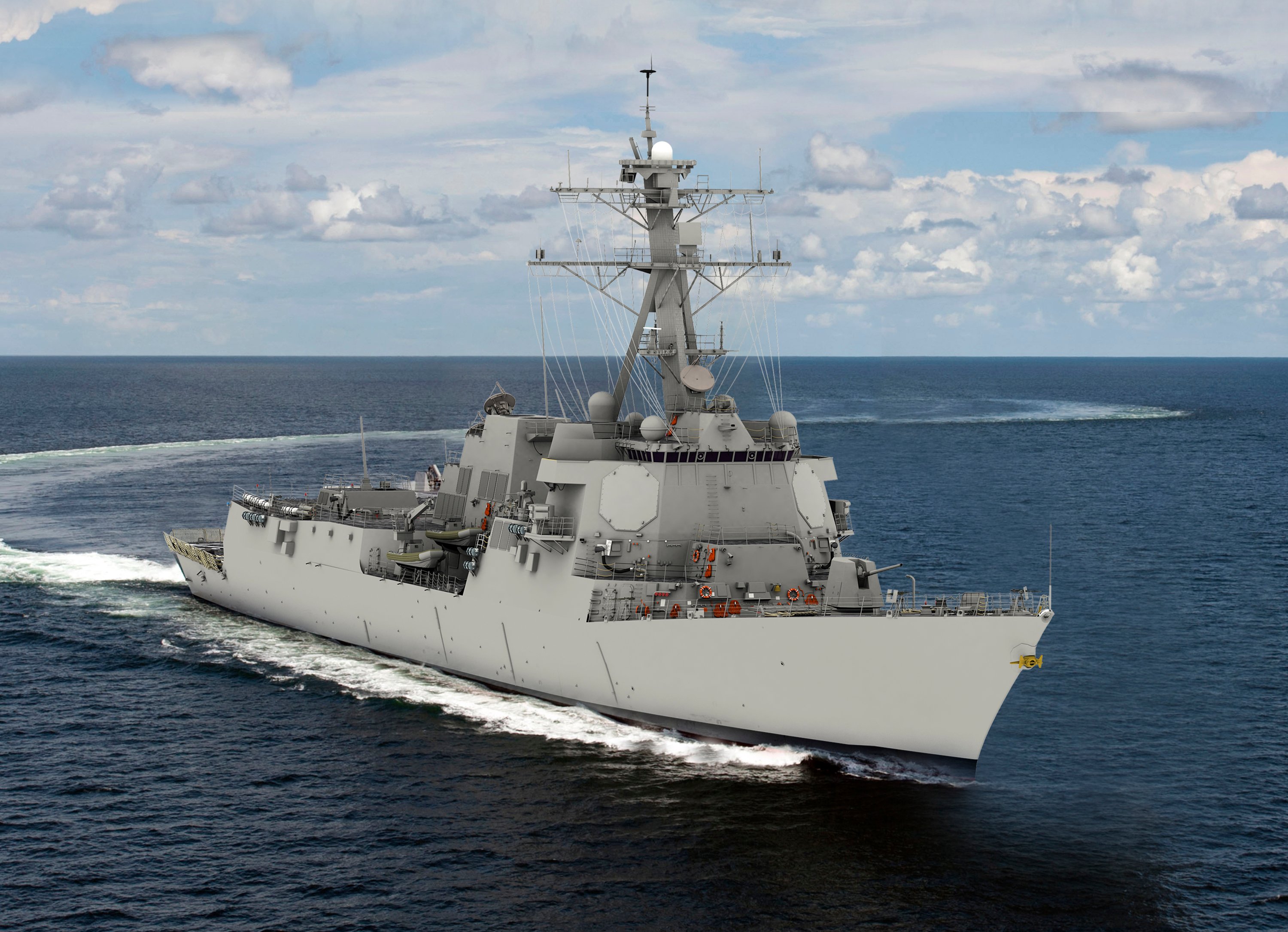
On the current Arleigh Burke-class production line, the Navy in February released a request for proposals for a five-year contract for up to 15 DDGs. In September, the service awarded six ships to Ingalls Shipbuilding and four to General Dynamics Bath Iron Works (BIW), as the baseline two-a-year DDG production rate the Navy originally wanted. The contract included options for as many as five more ships, to accelerate the program to help reach 355 ships faster. Though Congress did not give the Navy money for a third ship in Fiscal Year 2018, in December the Navy awarded an option for a third FY 2019 ship to BIW.
In another move meant to help accelerate the build-up to 355 ships, the Navy stated in April that it would extend the life of the entire Arleigh Burke class to 45 years, keeping the ships around longer for a minimal investment in an additional maintenance availability later in the hulls’ service lives.
On the Zumwalt program, the future Michael Monsoor (DDG-1001) had an eventful year: after the ship completed its acceptance trials in February – its second attempt, after the first go at acceptance trials in December 2017 was halted due to a failure in the Integrated Power System – and was partially delivered to the Navy in April, the Navy later acknowledged that the ship couldn’t actually depart the shipyard yet for its future homeport of San Diego because a main turbine engine blade had been damaged during sea trials. The Navy and BIW spent several months swapping out the entire engine, before Monsoor was able to depart the Maine shipyard in November and arrive in San Diego in December.
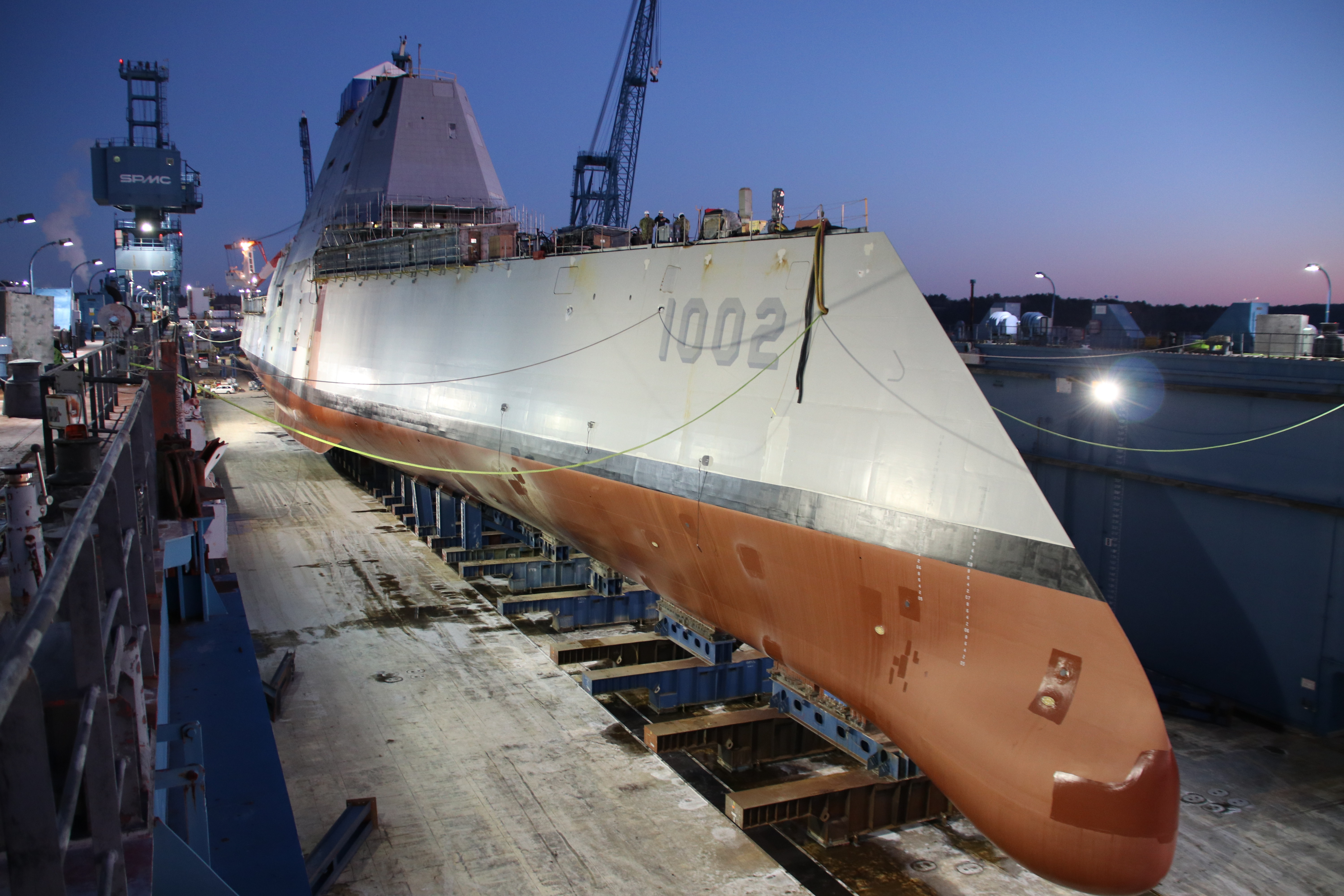
The third and final ship of the class, the future Lyndon B. Johnson (DDG-1002), launched from its drydock at BIW and was put into the water.
The Navy will continue to buy three LCSs a year through 2019, ahead of the move to the frigate in 2020, to address congressional concerns about the industrial base, despite the Navy’s wish to just buy one in 2019.
On the Navy’s Expeditionary Sea Base (ESB) program, a flood at a General Dynamics NASSCO graving dock damaged the under-construction Miguel Keith (T-ESB-5) and set its construction and delivery back by at least six months.
Carriers
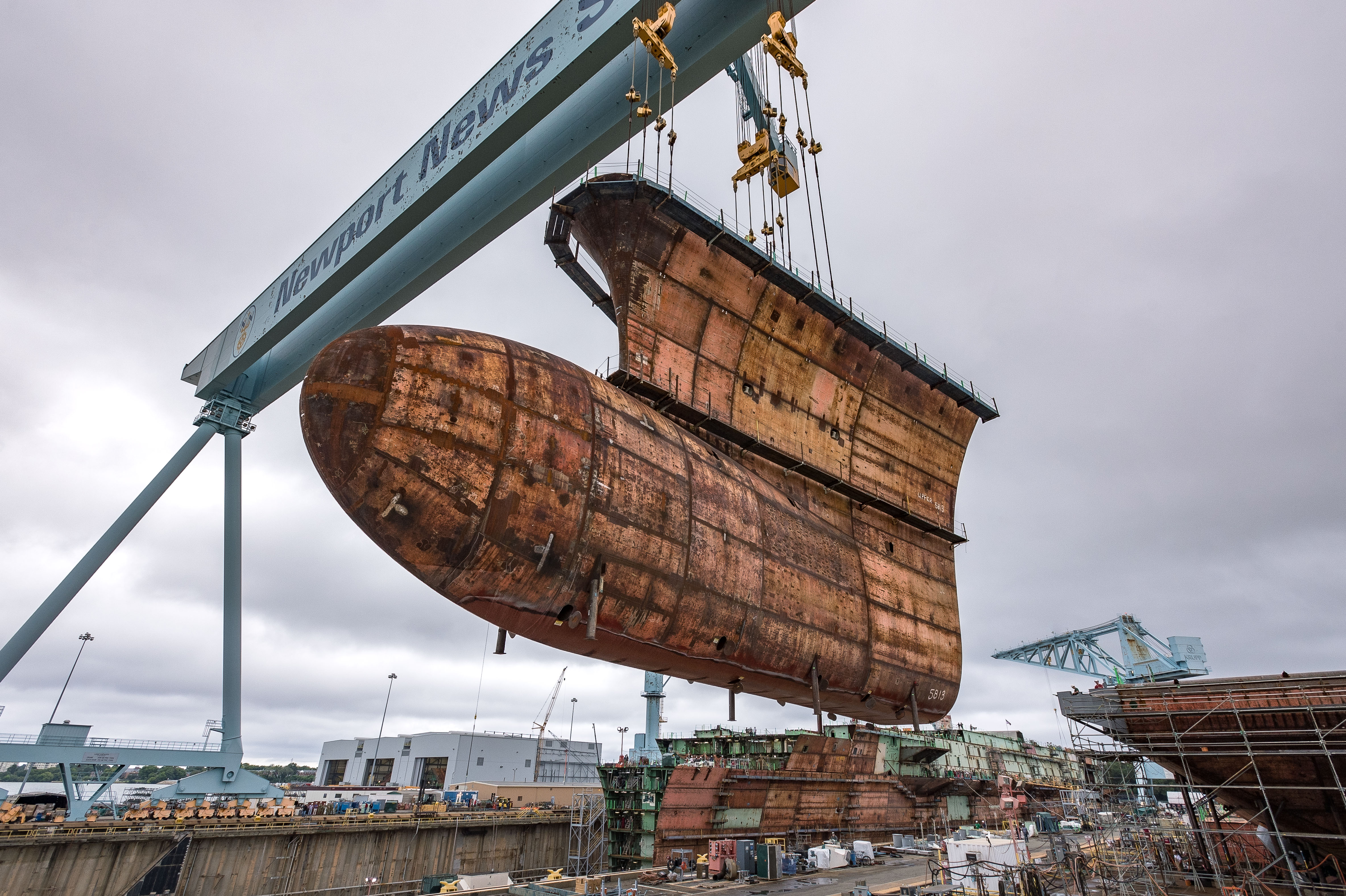
In March, the Navy officially asked Newport News Shipbuilding for more information on the cost and schedule savings associated with buying CVN-80 and 81 together in a single contract. The deal would be the first time since the Reagan Administration that two carriers were bought together. Newport News said it could save $1.6 billion due to workforce stability, engineering and planning both ships at once instead of through separate processes a few years apart, and economic order quantity savings in the supply chain. The Navy originally said it could save $2.5 billion overall – through the savings at Newport News and on the government-furnished equipment side – and now believes it can save even more than that. The Pentagon gave the Navy approval to execute a two-carrier contract in late December and Congress is reviewing the proposal.
The Navy’s newest in-service carrier, USS Gerald R. Ford (CVN-78), completed its shakedown period of at-sea testing and training in July and returned to Newport News Shipbuilding for a yearlong post-shakedown availability (PSA). The second Ford-class carrier, the future John F. Kennedy (CVN-79), is more than halfway complete and should launch by the end of 2019.
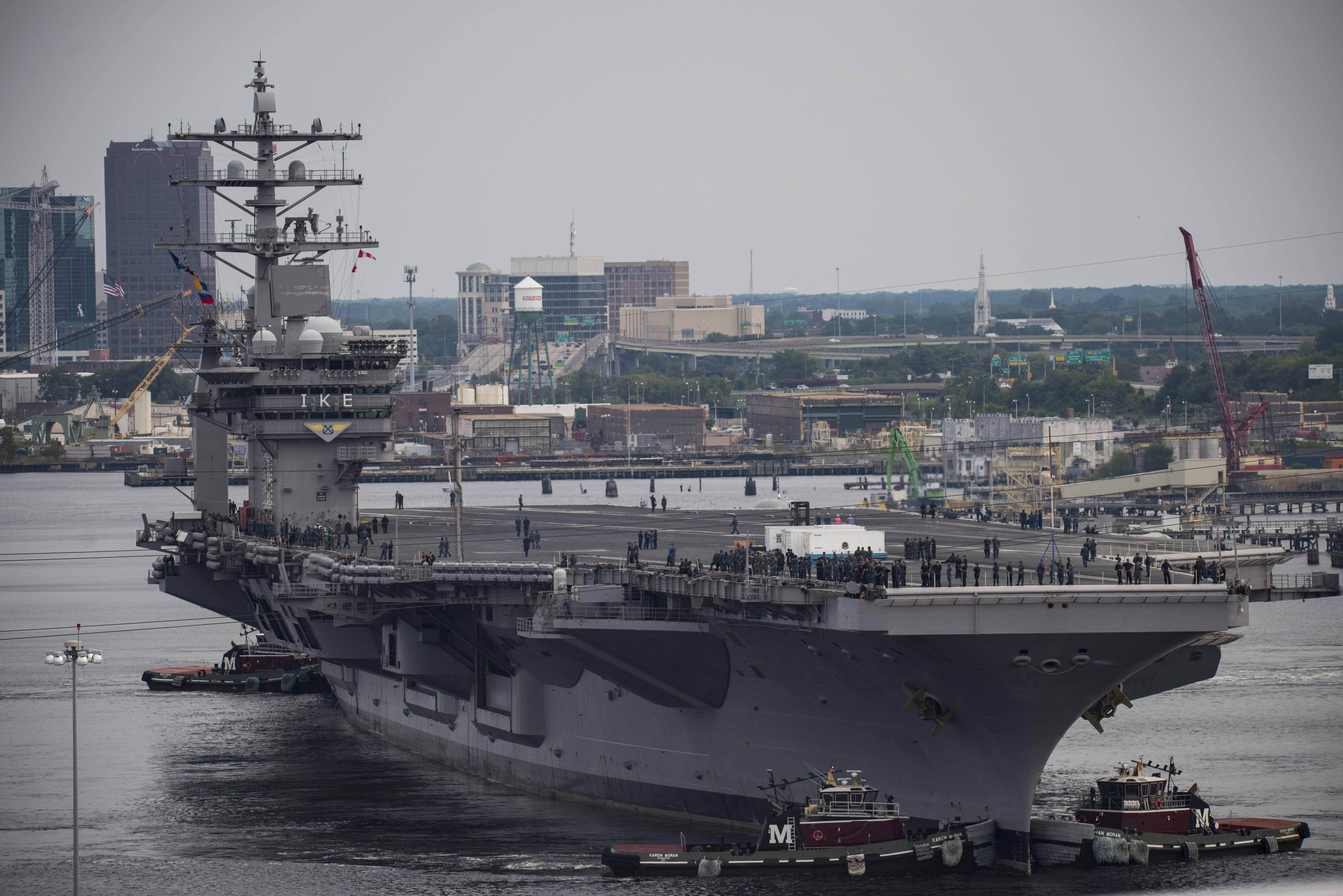
On the older end of the carrier fleet, USS Dwight D. Eisenhower (CVN-69) saw challenges during an availability at the Norfolk Naval Shipyard, and its planned six-month availability may triple in length or more. In November the ship announced it could move from the public yard back to Naval Station Norfolk to finish up the repair and maintenance work there, getting out of the way of the next carrier that needs maintenance and allowing Ike’s crew to do their work from their normal homeport instead of traveling across town to the Portsmouth, Va., repair yard.
Amphibs
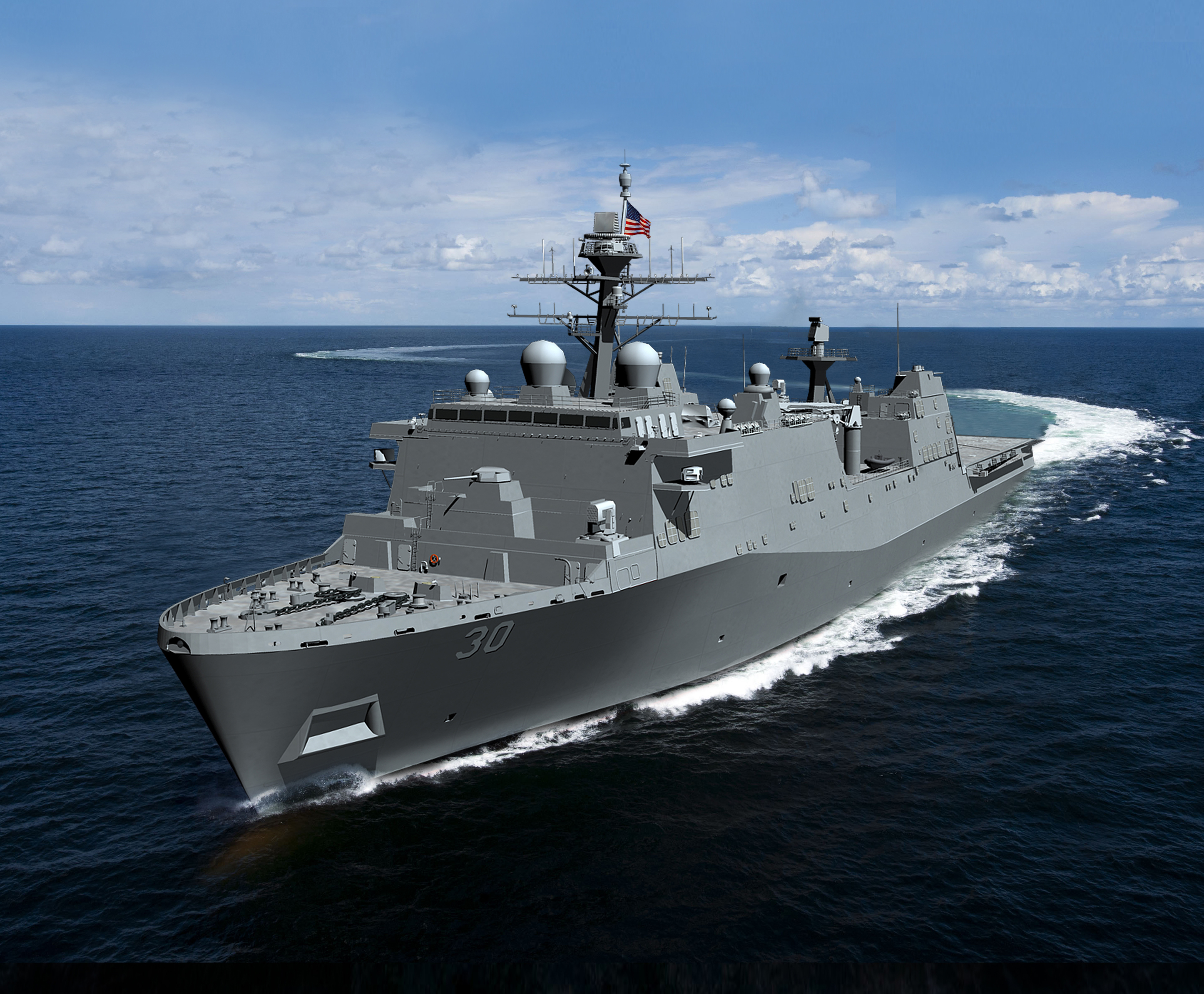
2018 showed that the Navy was taking its amphibious warship fleet seriously, with several moves that will bring new capability to a fleet that is struggling to keep up with the Marine Corps’ needs.
In January, the Navy determined that its LPD-30 San Antonio-class amphibious transport dock – the 14th in the class – would be the first to officially make the move to what had been known as the LX(R) program to replace Whidbey Island-class dock landing ships. The LPD program had continued to grow, as Congress paid for more and more “bridge ships” to keep the LPD production line going until an LX(R) solution was decided on. With the 14th being dubbed the first of the new LX(R) program, the Navy then announced three months later that LX(R) would formally be called LPD Flight II. With the bridge ships already bearing the brunt of the changes between the original San Antonio class and the envisioned LX(R), the differences between the last Flight I ship, LPD-29, and LPD-30 will be minimal. The move also ensures that the LSD-41/49 ships will be replaced by a much more sophisticated platform.
Conversations on Capitol Hill quickly moved to how fast the Navy could buy these ships and if they could be upgunned to include vertical launch systems or other weapons.
Looking farther down the road, an Amphibious Warship Evolution Plan is in the works within the Navy’s expeditionary warfare community. Led by Marine Corps Maj. Gen. David Coffman (OPNAV N95), the effort would seek to boost the San Antonio-class LPDs into a middleweight fighter more like a destroyer, upgrading the command and control and communications systems on the large-deck amphibious assault ships to better leverage the F-35B Joint Strike Fighter and other new sources of data in high-end warfare, and increase the number and the readiness of amphibs in the fleet.
In October, Ingalls Shipbuilding began fabrication of the future USS Bougainville (LHA-8), the third of the new America-class LHAs and the first that will reintroduce a well deck back into the design to support surface connector operations.
Submarines
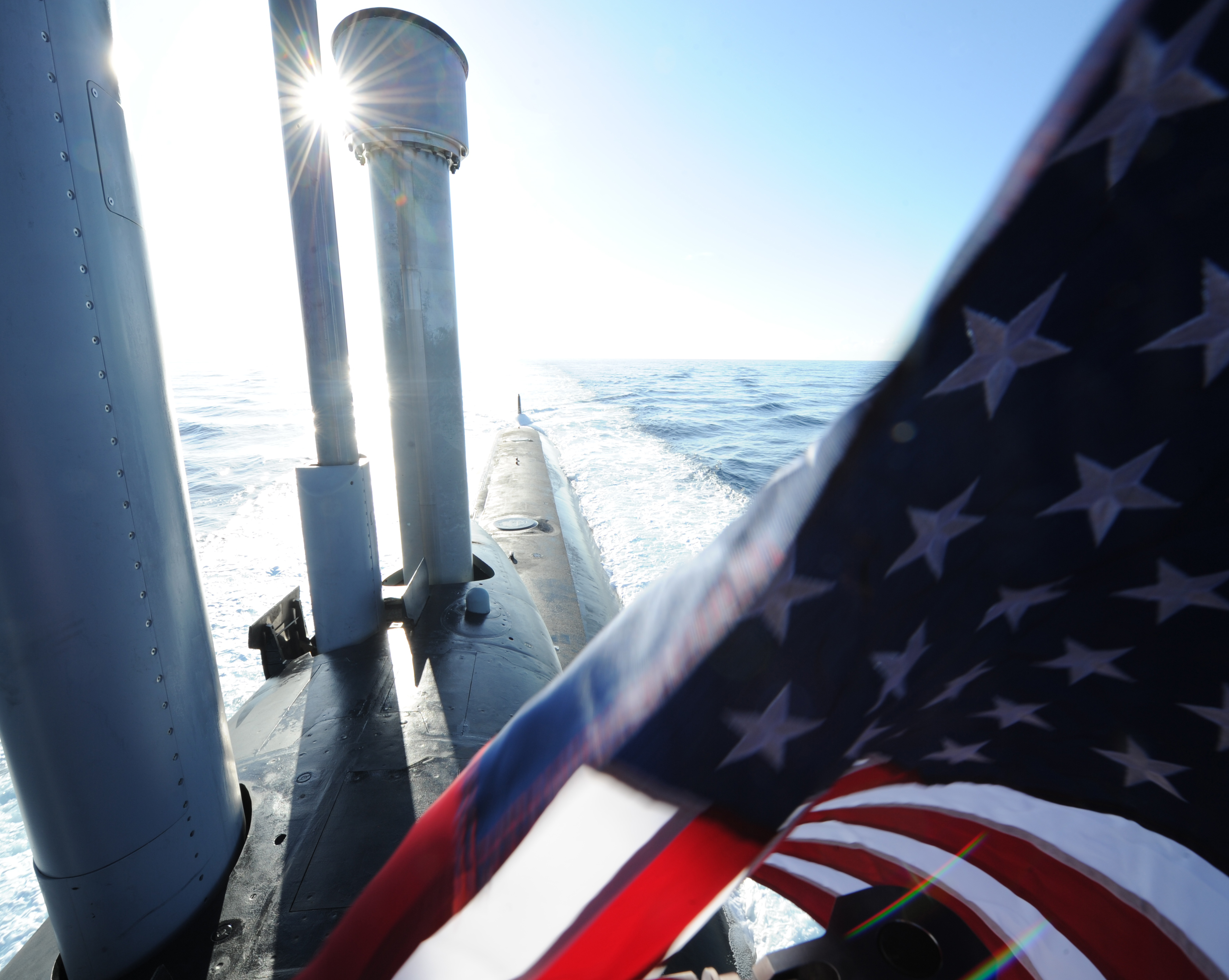
The Navy’s top acquisition priority, the Columbia-class ballistic-missile submarine (SSBN), appears to be still on track for a planned maiden deployment in 2031 despite a manufacturing delay this year. In August, the Navy acknowledged that some of the welds on BWX Technologies-made missile tubes were not properly done and would have to be re-welded. In November, the Navy said that rework would cost $27 million and take a year. Though the program overall has no schedule margin left, the missile tubes themselves had 23 months of margin built into their schedule and redoing the welding work and inspections would eat up about 10 months of that margin. CNO Richardson told USNI News he still believes the program can buy back some schedule despite previous delays, and could even deploy the first hull before 2031.
Despite ongoing work by the House and Senate armed services committees to create a fund to pay for the Columbia class and allowed shared parts-buying with the Virginia- and Ford-class programs, the Navy still hadn’t received permission from the Pentagon to buy the SSBNs through that fund and outside of the shipbuilding account. If the boomers are paid for with the shipbuilding account, there is a fear that other programs, like destroyers and amphibious ships, may suffer due to lack of sufficient funding. Paying for the Columbia class outside the shipbuilding account would ease some pressure on the rest of that budget account.
On the Virginia-class attack submarine, in March the Navy awarded lead builder General Dynamics Electric Boat a long-lead materials contract for Block V boats, which will be procured from FY 2019 through 2023.
Planning for a future SSN(X), which would come after Block VII Virginia-class hulls, took a turn in focus towards anti-Russian sub and ship capabilities, with the Navy putting more emphasis on torpedo tubes than vertical launch cells for land-attack missiles.
Weapons
In a demonstration in front of an international audience, the Navy used a Harpoon missile to sink a surface ship for the first time in more than 20 years during the Rim of the Pacific (RIMPAC) 2018 exercise. Commander of U.S. Pacific Fleet’s Submarine Force Rear Adm. Daryl Caudle said he expects that the cruise missile will be added back into the SSN’s regular armament after the successful demonstration, and the Program Executive Office for Submarines agreed they were looking for additional weapons to put on attack subs beyond just the Mk 48 torpedo and the Tomahawk Land-Attack Missile the SSNs have carried in recent years.
Either submarines or surface ships could be the beneficiary of Navy investments in a conventional prompt global strike hypersonic weapon that could hit any location on the planet within an hour. The Navy is now developing the glide body that all services would use for their prompt global strike capabilities, and the Navy would also develop a booster to launch the weapon from its eventual platform of choice – which had previously been discussed as being the Ohio-class guided-missile submarine but now is open to potentially another submarine or surface ship.
The LCS program demonstrated its surface-to-surface missile module (SSMM) in May, when USS Milwaukee (LCS-5) fired four AGM-114L Longbow Hellfire missiles that successfully struck fast inshore attack craft (FIAC) targets during SSMM developmental testing. To go after longer-range threats, the Navy announced a few weeks later it had selected the Naval Strike Missile to serve as an over-the-horizon anti-ship missile and would award Raytheon a $14.8-million contract for the first round of missiles.
The Evolved Seasparrow Missile (ESSM) Block 2 anti-air missile proved out its new active guidance seeker-head in a July test event, intercepting a BQM-74E aerial target. Raytheon was awarded a $77-million contract on May 18 to begin the transition from ESSM Block 2 engineering, manufacturing and development (EMD) into low-rate manufacturing, fabricating and production.





